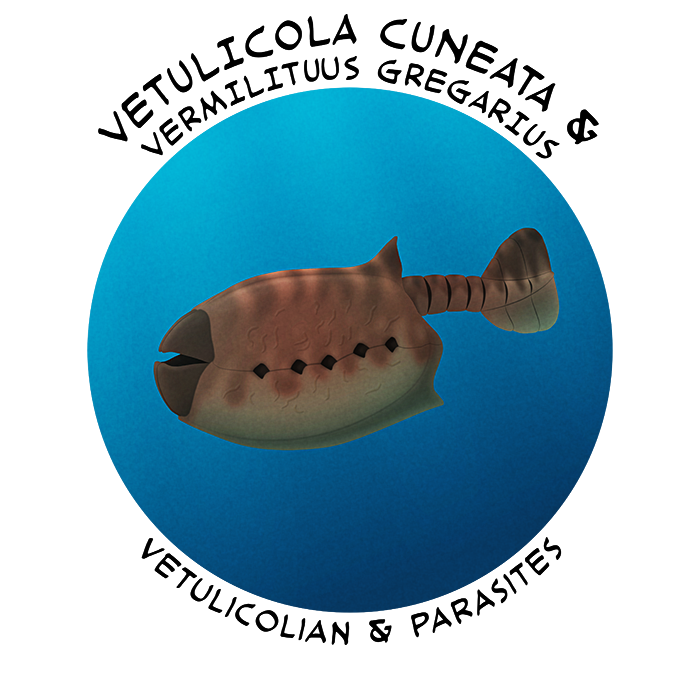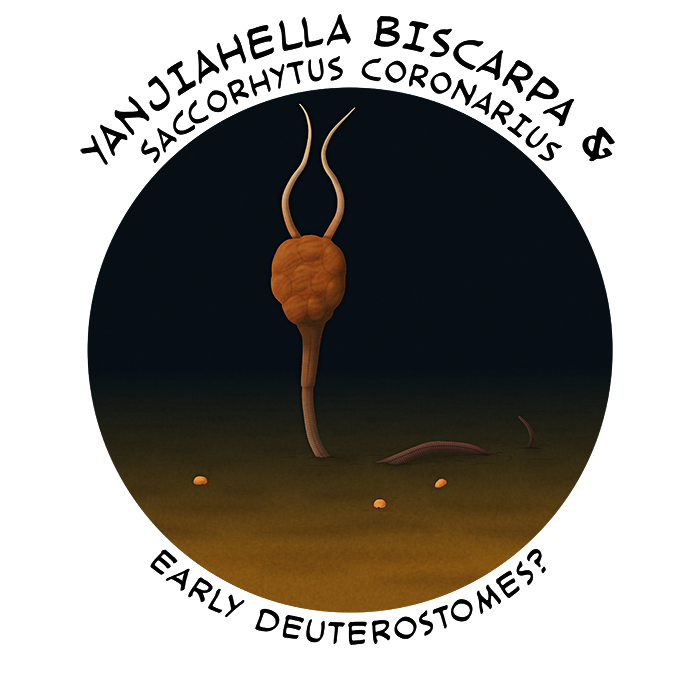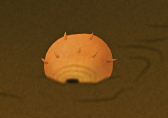Vetulicolians were a group of odd Cambrian animals known from between about 520 and 505 million years ago. The front half of their bodies were large and streamlined, with a prominent mouth, no eyes, and five pairs of openings that seem to have been gills, with some species having a rigid exoskeleton-like carapace. Their back half was slender, segmented, and flexible, and functioned as a tail for swimming, giving them an overall appearance like alien tadpoles.
Their evolutionary affinities have been problematic for a long time, but evidence of a notochord in some specimens suggest they were probably related to the chordates in some way. Sometimes they’re considered to represent their own phylum, but they might also be stem-chordates or stem-tunicates.

Vetulicola cuneata is known from the Chinese Chengjiang fossil deposits (~518 million years ago). Around 7cm long (2.75″), it had a prominent stabilizing keel on its underside and a dorsal fin-like structure on its back, suggesting it was an active swimming animal.
It was probably a filter-feeder, but large amounts of sediment found preserved inside its gut may indicate that it was a detritivore, scooping up mouthfuls of organic matter from the seafloor
A few specimens are infested by a small tubeworm-like creature, Vermilituus gregarius. These animals appear to have lived in the voluminous front body cavity of V. cuneata, embedded inside its carapace, and may have been parasitic – possibly “stealing” food particles their host was filtering. Some individuals were heavily infested, carrying as many as 88 of these worms, which probably caused a significant biofouling effect on their hydrodynamics.
The stalked animal Cotyledion tyloides has also sometimes been found attached to the tip of V. cuneata‘s tail, probably opportunistically filter-feeding on its poop.

Yanjiahella biscarpa was an early deuterostome, but it’s hard to say anything more definite about it. Known from the Chinese Yanjiahe Formation, it dates to the very start of the Cambrian about 541-535 million years ago, and has been tentatively classified as a very early echinoderm – which would make it 15-20 million years older than any other definite echinoderm fossils.
But its anatomy is ambiguous, with some hemichordate-like features and no evidence of echinoderms’ characteristic calcite skeleton. It’s not clear where it actually belongs in the deuterostome family tree – it could be an echinoderm, but it could also be a hemichordate, an early ambulacrarian, or part of a separate early deuterostome stem lineage.
Up to 5cm long (2″), it had a muscular stalk-like appendage, an irregularly plated body, and two tentacle-like feeding appendages. If it was an echinoderm, it would represent a very early bilaterally-symmetric form, with later bilateral forms like Ctenoimbricata losing the stalk and feeding appendages before other echinoderms re-evolved similar structures later on.
Living at the same time as Yanjiahella, in a nearby region of China, a tiny animal called Saccorhytus coronarius may have been another weird early deuterostome.

It had a globular body, only about 1.3mm long (0.05″), with several small cone-like or spine-like structures and a prominent mouth surrounded by nodular ridges, making it look like a tiny screaming potato. It didn’t seem to have an anus – but it’s not clear if it just wasn’t visible in the minuscule fossils, if it represents an ancestral state inherited from earlier bilaterians, or if it was a secondarily lost feature like in modern brittle stars.
It’s been interpreted as being closely related to the vetulicolians, but there’s also a possibility it wasn’t a deuterostome at all. Another analysis has found it to instead be an early ecdysozoan, closer related to the scalidophorans – although this study hasn’t been properly peer-reviewed yet, so it’s unclear how accurate it is.
